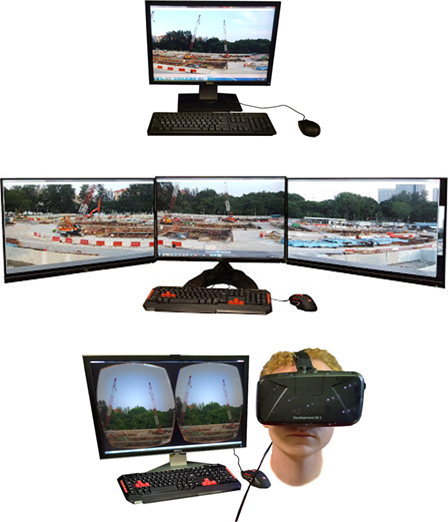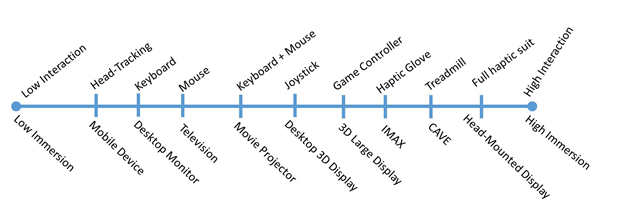Immersion, Presence, and Interaction
We have already discussed that the renewed interest in virtual technology, the fidelity, and overall quality of information presented in virtual environments are vastly improving. These improvements are not only propelling VR technologies into living rooms and research facilities, but they also have the potential to impact on spatial experiences that users have with virtual environments from the inside of a volcano to the Mayan ruins to informal settlements in Rio. In several studies, it has been shown that these spatial experiences may have positive influences on knowledge development and transfer to a real-world application (Choi & Hannafin, 1995). In other words, by enhancing one’s intensity of the experience, it may offer a way to facilitate learning through understanding and engagement. The literature on spatial experiences within virtual environments, however, is full of ambiguous concepts centered around the relationship between presence, immersion, and interactivity. In bringing conceptual clarity to distinguish these concepts, knowledge derived from previous research can become easier to implement and evaluate. This knowledge can then help to clarify the importance of spatial experiences for systems that enable experiences that only virtual environments can offer. We start the discussion by distinguishing between presence and immersion, defining dimensions of presence, and examining knowledge built from spatial experiences.
How difficult it is to characterize these concepts should become apparent when you try to define, for example, immersion, yourself. The problem with most scientific concepts is the term we use to describe a concept often also has meaning in everyday language (mathematicians get out of this mess by using symbols, e.g., π, and then define what it means). When we think of immersion we have a couple of options defining its meaning. When my kids watch their 20 minute TV show every other evening (Masha and the Bear for the 2-year-old, Word Girl for the 5-year-old), I experience the power of immersion first hand. I would describe their state as being glued to the TV and if unresponsiveness is a measure for immersion than I could make an argument that we really do not need VR. Everyone probably has made similar experiences reading a book whether It or Harry Potter that has taken you under their spell. In becoming engaged with the media, you start to feel a part of the story, feeling present in the space.
Yet, from a technology perspective immersion can be defined differently. For example, in the work by Slater (1999), immersion is distinguished from presence with the former indicating a physical characteristic of the medium itself for the different senses involved. Furthermore, according to Witmer and Singer (1998) immersion is defined as “a psychological state characterized by perceiving oneself to be enveloped by, included in, and interacting with an environment that provides a continuous stream of stimuli and experiences” (ibid, page 227). Witmer and Singer have also argued that immersion is a prerequisite for experiencing presence.
To give you a simple example of immersion, the figure below shows three setups that we used in a recent study on how different levels of immersion influence the feeling of being present (more below) in a remote meeting. We compared a standard desktop setting (the lowest level of immersion) with a three-monitor set up (medium level of immersion) against using an immersive headset (here the Oculus Rift). You can order these technologies as we have just done along a spectrum of immersiveness which then helps to design, for example, experiments to test whether or not being physically immersed has an effect, for example, on the subjective feeling of team membership. Imagine that instead, you are using Skype (or zoom, or any other video conferencing tool) but instead of staring at your single monitor, the other person is streaming a 360-degree video directly into your VR HMD.

In contrast, the nature of presence in and of itself is highly subjective, making it hard to distinguish from concepts like immersion (well, we just did). The sense of presence is indeed the subjective sense of being in the virtual environment (Bulu, 2012). Many smart people have thought about this and to make things more fun have developed further distinctions such as spatial presence, co-presence, and telepresence. Sense of presence seems to be, interestingly enough, related to immersion and several studies have shown that immersive capabilities of technology, specifically VR technology, impact the subjective feeling of presence (Balakrishnan & Sundar, 2011). Therefore, different configurations of technology to increase immersive capabilities should increase the sense of presence experienced by a user (well, it is a plausible hypothesis).
The relationship between immersion and presence forms at the point when user attention is focused (or absorbed) enough to allow for involvement in the content to become engaged with the digital environment (Oprean, 2014). This relationship allows for a clear distinction between immersion and presence while enabling a framework for measuring the influence of one on the other. On similar grounds, and as was previously mentioned, Witmer and Singer (1988) argue that both immersion and involvement are prerequisites for experiencing presence in a virtual environment. Involvement from their perspective is defined as “a psychological state experienced as a consequence of focusing one's energy and attention on a coherent set of stimuli or meaningfully related activities and events” (ibid, page 227), and also related to other concepts similar to engagement such as the “flow state” introduced by Csikszentmihalyi (1992).
Presence is a large and heavily measured construct in research on spatial experiences. The construct of presence consists of a number of dimensions specific to different contextual purposes: spatial, co-, tele-, social, etc. Each dimension of presence is considered with the same foundational meaning: that a user feels ‘present’ within a given medium, perceiving the virtual content (Steuer, 1992). The different dimensions, however, help to further distinguish the context or situation in which presence occurs.
The dimensions of presence cover a range of contextually different concepts that are often used interchangeably (Zhao, 2003). Telepresence distinguishes itself through its original context, teleoperation work (Sheridan, 1992). Steuer (1992) defines telepresence as distinguishable from presence by suggesting it refers to the experience of a secondary, such as virtual, environment through a communication medium. Taking both of these distinctions into account, telepresence, as related to its context of teleoperation, suggests that perceptions relate to experiencing a virtual environment in which work (i.e., interaction) can occur through a communication medium. This definition relates to the development occurring in collaboration research with telepresence systems; systems meant to mediate a sense of presence to enable work on tasks, individually or collectively.
Co-presence is similar, yet a different dimension of presence, than telepresence. Nowak and Biocca (2003) note the distinctions between telepresence and co-presence as pertaining to connection with others. Whereas telepresence can occur without other individual’s involvement, co-presence is dependent on another human being present to connect with through a communication medium. This human connection is what distinguishes co-presence from telepresence, a focus on a human-human relation (Zhao, 2003).
Social presence, another dimension of presence, has a similar definition to co-presence but requires a group of humans to connect with (Nowak & Biocca, 2003). Gunawardena and Zittle (1997) further the definition of social presence stating it is the degree of perceived realness of a person in a mediated communication. This perception of realness is dependent on two concepts: intimacy and immediacy (Gunawardena & Zittle, 1997).
Spatial presence builds on the foundational definition of presence, the feeling of being in an environment. Steuer (1992) notes that with any mediated communication there is overlap with the physical (real world) presence. Spatial presence there relates to the believability of being present within the mediated space, making spatial presence purely experiential.
In distinguishing the dimensions of presence, it becomes easier to establish factors which impact the level at which a user’s perception of being a part of a mediate space. In particular, such a distinction is necessary to understand the true implications of telepresence systems and how the initial sense of being a part of a mediated space impacts teamwork.
Interaction, in contrast, seems to be somewhat more straight forward and less troublesome to define than the concepts of immersion and presence. However, like with most things, once you dig deeper into it you will find that it is not so straight forward after all to make distinctions, especially when more than one modality is involved. Interaction can be broken down into dimensions such as navigation (whether an environment is navigable or not), does the interface allow for interaction and which modality is involved (gaze used often in cardboard environments versus haptic gloves), and human agency, which could relate to navigability but it also could be a measure of how much a user is able to interact with and/or manipulate a particular environment.
Instead of trying to further define these concepts we ask you to have a look at the Figure below. Most concepts we discussed can be arranged on a spectrum from high to low (especially immersion and interactivity). This distinction is useful when we think about different VR technologies.

To summarize, this section provided a glimpse into the more academic discussion of how to conceptualize virtual reality. We briefly discussed important concepts such as immersion, presence, and interactivity and showed exemplarily how everyday use of the terms may interfere with their more academic definitions (although even academics get lots in these discussions). Distinguishing VR technologies along the dimensions of these concepts, for example, from high to low levels of immersion, is useful to a) talk about categories of technology rather than individual products; b) to start investigations of which technology might actually help in communicating or making decisions about space and place in the past, present, and future.
References
Balakrishnan, B., & Sundar, S. (2011). Where am I? How can I get there? Impact of navigability and narrative transportation on spatial presence. Human-Computer Interaction, 26(3), 161-204.
Bulu, S. T. (2012). Place presence, social presence, co-presence, and satisfaction in virtual worlds. Computers & Education, vol. 58, no. 1, pp. 154–161.
Csikszentmihalyi, M. & Csikszentmihalyi, I. S. (1992). Optimal experience: Psychological studies of flow in consciousness, Cambridge university press.
Choi, J. I., & Hannafin, M. (1995). Situated cognition and learning environments: Roles, structures, and implications for design. Educational technology research and development, 43(2), 53-69.
Gunawardena, C. N., & Zittle, F. J. (1997). Social presence as a predictor of satisfaction within a computer‐mediated conferencing environment. American journal of distance education, 11(3), 8-26.
Nowak, K. L., & Biocca, F. (2003). The effect of the agency and anthropomorphism on users' sense of telepresence, copresence, and social presence in virtual environments.Presence: Teleoperators & Virtual Environments, 12(5), 481-494. doi:10.1162/105474603322761289.
Oprean, D. (2014). Understanding the immersive experience: Examining the influence of visual immersiveness and interactivity on spatial experiences and understanding. Unpublished doctoral dissertation, University of Missouri.
Sheridan, T. B. (1992). Musings on telepresence and virtual presence.Presence: Teleoperators & Virtual Environments, 1(1), 120-126.
Slater, M. (1999). Measuring presence: A response to the Witmer and Singer presence questionnaire. Presence: Teleoperators and Virtual Environments,8(5), 560-565.
Steuer, J. (1992). Defining virtual reality: Dimensions determining telepresence. Journal of communication, 42(4), 73-93.
Witmer, B. G. & Singer, M. J. (1998). Measuring presence in virtual environments: A presence questionnaire, Presence 7 (3), 225–240.
Zhao, S. (2003). Toward a taxonomy of copresence. Presence: Teleoperators and Virtual Environments, 12(5), 445-455.